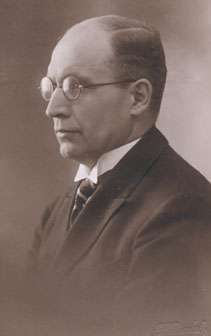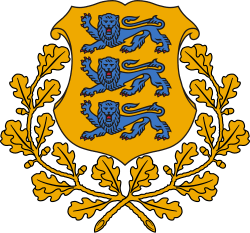Jüri Uluots
| Jüri Uluots | |
|---|---|
 Jüri Uluots | |
| Prime Minister in duties of the President | |
|
In office 20 June 1940 – 9 January 1945 | |
| Preceded by | Konstantin Päts |
| Succeeded by | August Rei |
| Personal details | |
| Born |
13 January 1890 Kirbla Parish, Lääne County, Russian Empire |
| Died |
9 January 1945 (aged 54) Stockholm, Sweden |
| Alma mater | St. Petersburg University |
Jüri Uluots (13 January 1890 – 9 January 1945) was an Estonian prime minister, journalist, prominent attorney and distinguished Professor and Dean of the Faculty of Law at the University of Tartu.
Early life
Uluots was born in Kirbla Parish, Lääne County in 1890 and studied law at St. Petersburg University in 1910 – 1918. He subsequently taught Roman and Estonian law at the University of Tartu until 1944. Uluots was also an editor of the Kaja newspaper from 1919–1920, and editor-in-chief of Postimees from 1937–38.
Political career
Uluots was elected to the Riigikogu, the Estonian parliament, for 1920–1926, and from 1929 through 1932. He was speaker of the Riigivolikogu (lower chamber) from 4 April 1938 to 12 October 1939. Uluots then served as prime minister from 1939 until June 1940 when Soviet troops entered Estonia and installed a new Soviet puppet government led by Johannes Vares, whereas Uluots' constitutional government went underground (and later, in exile). The communist puppet government was never recognized by the United States, United Kingdom and other western powers who considered it and the August 1940 annexation of Estonia into the USSR illegal.[1]
After the Estonian President Konstantin Päts was arrested by Soviet occupation forces and deported to Russia in July 1940, Professor Uluots became prime minister in the duties of the president as dictated by the Estonian constitution. When the Nazis invaded Soviet-occupied Estonia in 1941 the communist government was overthrown.
Ulouts refused German offers to head the Estonian Self-Administration in 1941 and instead formed part of the underground Estonian resistance to the Nazi occupation regime.[2] In March 1944 the National Committee of the Republic of Estonia was formed by the underground resistance movement in German-occupied Estonia.[3] By April 1944 a large number of the committee members were arrested by the German security agencies.[4] The Committee aimed to establish of a provisional government during expected German withdrawal as the Red Army had reached the border of Estonia on 2 February 1944. On 20 April 1944, the National Committee selected the Electoral Committee of the Republic of Estonia. The Committee determined that the Soviet-era appointment of Johannes Vares as Prime Minister by Konstantin Päts had been illegal and that Uluots had assumed the President's duties from 21 June 1940 onwards.[5] On 21 June 1944, Jüri Uluots appointed Otto Tief as deputy prime minister.[6]
In January 1944, the front was pushed back by the Soviet Army almost all the way to the former Estonian border. Narva was evacuated. Jüri Uluots delivered a radio address that implored all able-bodied men born from 1904 through 1923 to report for military service (Before this, Uluots had opposed Estonian mobilization.) The call drew support from all across the country: 38.000 draftees appeared at registration centers.[7] Several thousand Estonians who had joined the Finnish army came back across the Gulf of Finland to join the newly formed Territorial Defense Force, assigned to defend Estonia against the Soviet advance. It was hoped that by engaging in such a war Estonia would be able to attract Western support for the cause of Estonia's independence from the USSR and thus ultimately succeed in achieving independence.[8] As the Germans retreated in September 1944, Uluots appointed a new government, headed by Otto Tief.
On 20 September, the Estonian national government was proclaimed. Estonian forces seized the government buildings in Toompea and ordered the German forces to leave.[9]
Tief's government left Tallinn prior to the Soviet army's arrival and went into hiding. But most of the cabinet members were later arrested and suffered various repressions by the Soviet authorities, or were sent to labour camps in Siberia. The remainder of the government fled to Stockholm, Sweden, where it operated in exile from 1944 to 1992 when Heinrich Mark, who was prime minister in duties of the president, presented his credentials to incoming president Lennart Meri.
Uluots died shortly after arriving in Sweden in 1945.
Awards
1938 – Order of the White Star I
| Preceded by none |
Speaker of the Riigivolikogu 1938 – 1939 |
Succeeded by Otto Pukk |
| Preceded by Kaarel Eenpalu |
Prime Minister of Estonia 1939 – 1940 |
Succeeded by vacant |
| Preceded by President of Estonia Konstantin Päts 1938 – 1940 |
Prime Minister of Estonia In the Duties of the President 1940 – 1945 |
Succeeded by August Rei 1945–1963 |
References
- Mälksoo, Lauri (2000). Professor Uluots, the Estonian Government in Exile and the Continuity of the Republic of Estonia in International Law. Nordic Journal of International Law 69.3, 289–316.
- Article about Otto Tief's government from the official site of the Estonian Embassy in Moscow
- ↑ European Parliament (13 January 1983). "Resolution on the situation in Estonia, Latvia, Lithuania". Official Journal of the European Communities. C 42/78. "whereas the Soviet annexias of the three Baltic States still has not been formally recognized by most European States and the USA, Canada, the United Kingdom, Australia and the Vatican still adhere to the concept of the Baltic States".
- ↑ Raun, Toivo (2001). Estonia and the Estonians. Hoover Press. p. 163. ISBN 978-0-8179-2852-0.
- ↑ Smith, David James (2001). Estonia: Independence and European Integration. Routledge. p. 36. ISBN 978-0-415-26728-1.
- ↑ Miljan, Toivo (2004). Historical Dictionary of Estonia. Scarecrow Press. p. 21. ISBN 978-0-8108-4904-4.
- ↑ L. Mälksoo, Professor Uluots, the Estonian Government in Exile and the Continuity of the Republic of Estonia in International Law, Nordic Journal of International Law, Volume 69, Number 3 / March, 2000
- ↑ Chronology Archived 9 June 2007 at the Wayback Machine. at the EIHC
- ↑ Resistance! Occupied Europe and Its Defiance of Hitler (Paperback) by Dave Lande on Page 200 ISBN 0-7603-0745-8
- ↑ The Baltic States: The National Self-Determination of Estonia, Latvia and Lithuania Graham Smith p.91 ISBN 0-312-16192-1
- ↑ By Royal Institute of International Affairs. Information Dept. Published 1945

